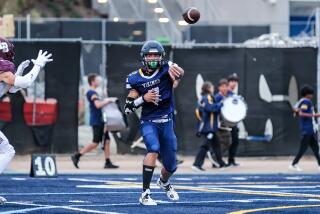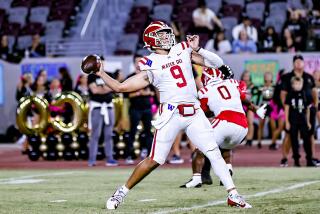The Sonoma Sleeper : Larry Allen, a 325-Pound Lineman From Division II School, May Go Early in the Second Round of the NFL Draft
- Share via
ROHNERT PARK, Calif. — The sleeper is having trouble sleeping. Larry Allen closes his eyes, and his mind does somersaults.
How did I get here? What happens next? How did they find me? Why did they find me?
It’s been this way for two months. At 1 a.m., he rolls his 6-foot-2, 325-pound body out of bed and stumbles to the living room.
On top of the TV is a rented movie. Sometimes there are three.
He sticks one in the VCR, leans back in a chair and searches for the moment his eyes will close, his fears will disappear and he will finally accept that he deserves it.
Yes, he deserves being projected as an early second-round pick in today’s NFL draft.
Yes, even though he might be the only player picked who did not attend college on an athletic scholarship.
Yes, even though two years ago he was living in Compton and not even attending college.
Yes, even though he went to four high schools in four cities, played football for only two of them and graduated from none.
Yes, even though he has been stabbed, shunned, stood up, slapped down and ignored.
Larry Allen, from Sonoma State tackle to NFL millionaire.
The sleeper wonders if he will ever be able to sleep.
“Every time I close my eyes I think, ‘Damn, man, how can this happen?’ ” Allen said.
*
While selling itself to TV as a coronation of superstars, the NFL draft remains rooted in meanings far different.
The romance that has endured for the 59 years of this exercise is not about the destinations of All-Americans.
It is about the discovery of Larry Allens.
For the millions who have watched the draft, the message about football in America has always been clear.
If you can play, the NFL will find you. Somewhere, somehow, the pros will find you.
The league found Allen during routine scouting trips by friends of friends of team officials. He was then allowed to play in the East-West Shrine Game and Senior Bowl, the thought being that he would be exposed by top competition.
But in both games, this soft-spoken giant dominated opponents with an unmatched ferocity. Scouts say he pounded heralded University of Miami defensive lineman Darren Krein so badly that Krein quit.
“When I’m on the field, I’m like a gang-banger,” Allen said quietly. “I hit as hard as I can for as long as I can. I think maybe I’m taking out all my frustrations about my life.”
After probing his body and his past for the last two months, league officials promise that today or Monday, that frustration will end.
“Larry Allen is a great story,” said Carl Peterson, general manager of the Kansas City Chiefs and former Sonoma State coach. “Been through a lot in his life, bounced around a few places, but now, somebody is going to give him a real good opportunity. Second round--or even higher.”
That opportunity will mark the first time in the 16-year history of Sonoma State football that a player from there has been taken in the NFL draft.
Not only does the Division II program not give athletic scholarships, it has only three full-time coaches and a stadium with no lights and one set of bleachers.
During a recent spring practice, the best moves were performed by a running back who leaped over a small boy playing on the sidelines.
The loudest voice belonged to the volunteer line coach, a computer science teacher at a local high school.
What must Allen have thought when he arrived here from Compton two years ago, his luck on empty, his opportunities drained?.
What must he have thought as he was driven from gang turf and barred windows to this hilly, picturesque spot an hour north of San Francisco?.
“I couldn’t believe how quiet it was here,” Allen said. “At first I thought, ‘Where am I?’ But then I realized, this was my last chance. I had to do it here, or nowhere.”
By that time, he was so familiar with nowhere he could have given tours.
As a 9-year-old in Compton, he was stabbed 12 times in the head and shoulder during a fight with a playmate whose mother had given him a knife.
After a massive stitching job at the hospital, he became so frightened of needles that today he won’t even allow his dentist to administer Novocain before filling a cavity.
By the time he reached adolescence, his parents had separated. His mother took him to Northern California to escape the bullets.
Some say those bullets were how Allen developed what scouts calls incredible quickness.
“We would hear the gunfire outside our house, we would automatically roll out of the bed, lay on the floor until the shooting stopped, then get back in bed and go to sleep,” said his mother, Vera. “After a while, we got pretty good at that.”
Because he could not afford to play Pop Warner football, he needed to work up the courage before joining the freshman team at his first high school in Stockton.
But shortly after he signed up, his mother moved to Fairfield, which meant a change of schools. Uncomfortable in a new environment, he sat out his sophomore season.
By the time he was ready to play again, he had moved again, back to Compton, where he donned shoulder pads for the first time as a junior at Centennial High.
If he had stayed there, he might have been recruited by major schools. But with drug deals taking place outside his house, with gang activity forcing him to leave certain colored clothing in his closet, he asked his mother if he could return to Northern California.
He spent his senior year at a high school in Napa. With no diploma, and no SAT scores because he had never felt secure enough to make arrangements to take the test, he was of no use to interested major colleges.
So he enrolled in Butte Junior College in Oroville. By his second year there, he realized his chances of staying with football, or even in school, were slim.
He had no money. His mother had no money.
Once when he called home and told her he was hungry, she rushed down to a Western Union office in Compton with her last $32.
“It cost me $13 to wire him $15,” Vera recalled. “That was $28, and the man behind the counter thought it was a little silly. He wondered if I couldn’t just mail him the money.
“I said, ‘Mister, my son is hungry now .”
On another occasion at Butte when he was broke, Allen said he sold his athletic jacket to a drug dealer for a chance to sell rock cocaine with a friend on the street.
“But a police car drove past, I got scared, threw the bag in the bushes, and haven’t been near the stuff since,” he recalled. “That just wasn’t me.”
Allen returned home after his second year at Oroville, with no associate degree or direction. He had only the memories, growing ever distant, of something he once had heard about his potential.
He moved back into his mother’s house in Compton, borrowed plastic drugstore weights from a cousin and spent his days lifting those and watching TV. Lifting and watching and wondering.
“Those weights were tiny,” he said. “I would lift them 100 times. Every day, at least 100 times. I didn’t know what I was waiting for. I was just, you know, waiting.”
While he waited, Frank Scalercio, then an assistant coach at Sonoma, was searching. Scalercio had seen Allen dominate opponents at Butte, then heard that he had quit school.
In his previous nine years as an assistant at Sonoma, Scalercio had made a habit of bringing youngsters from South-Central Los Angeles to the college and teaching them about life. About 10 such athletes play for the Cossacks every season.
In Allen, he saw another such project.
“But I couldn’t find him,” Scalercio said. “His phone number kept changing as he moved around town. Friends kept seeing him, then not seeing him.”
Using every available contact in the Compton area, Scalercio finally reached Allen after nearly three months of trying. Allen picked up the phone, heard Scalercio’s pitch, and laughed.
“I never heard of Sonoma State,” Allen said. “I thought it was a joke.”
His mother finally persuaded him to give the rural college a chance. He showed up with his clothes piled into garbage bags in the back of another student’s pickup truck.
After his first 10 minutes on the field, Scalercio knew it was not merely another risk.
“Our first practice, he was killing people,” said Scalercio, who became head coach this year. “He was so mean. It was real ugly.”
It was almost as ugly as what was happening off the field.
Allen was so big, many in the Santa Rosa area stared at him. He interpreted these stares as challenges. There were several bloody, late-night fights.
“It was like a small guy in town would challenge him, then a bigger guy, then a bigger guy,” Scalercio said. “I had to teach him, like I have to teach a lot of our kids, that what the look may mean in South-Central, it means something different here.”
With more than half of his team from inner-city areas throughout California, Scalercio spends much of his time helping players adjust. Allen eventually stopped fighting and now sells his skills there as a paid bouncer and security guard.
But some adjustments couldn’t be made. Like the time Sonoma was playing at Northridge.
It was Vera Allen’s only chance to see her son play, but she doesn’t have a car. So she and her other son boarded a city bus in Compton for a three-hour ride to the game.
“I saw my mom afterward, and really wanted to visit with her, but she had to catch that bus home,” Allen recalled. “That was really hard.”
After dodging rats and drunks at the downtown station, Vera and her son arrived back in Compton at 2 a.m.
“One thing I really want to do is buy my mother a car,” Allen said.
With impending fame, though, has come other problems.
Allen gives away so much money to friends that Scalercio budgets his financial aid check, putting equal amounts in envelopes that are given to him weekly.
When a boy recently asked Allen for his autograph, Allen walked into his Scalercio’s office, pulled a color photograph off the wall, signed the picture, and handed it to the boy.
And don’t tell this to defensive linemen, but the other day, Allen and his girlfriend took a niece to Chuck E. Cheese.
“When all this is over, all I want is a place near a beach,” Allen said. “I want to be able to walk to the sand, throw down a blanket and look at the water.”
He was reminded that, like needles and airplanes, he is also afraid of the water.
“Doesn’t matter,” he said. “It’s quiet there. It’s pretty there. I just want to spend all day looking.”
More to Read
Go beyond the scoreboard
Get the latest on L.A.'s teams in the daily Sports Report newsletter.
You may occasionally receive promotional content from the Los Angeles Times.











